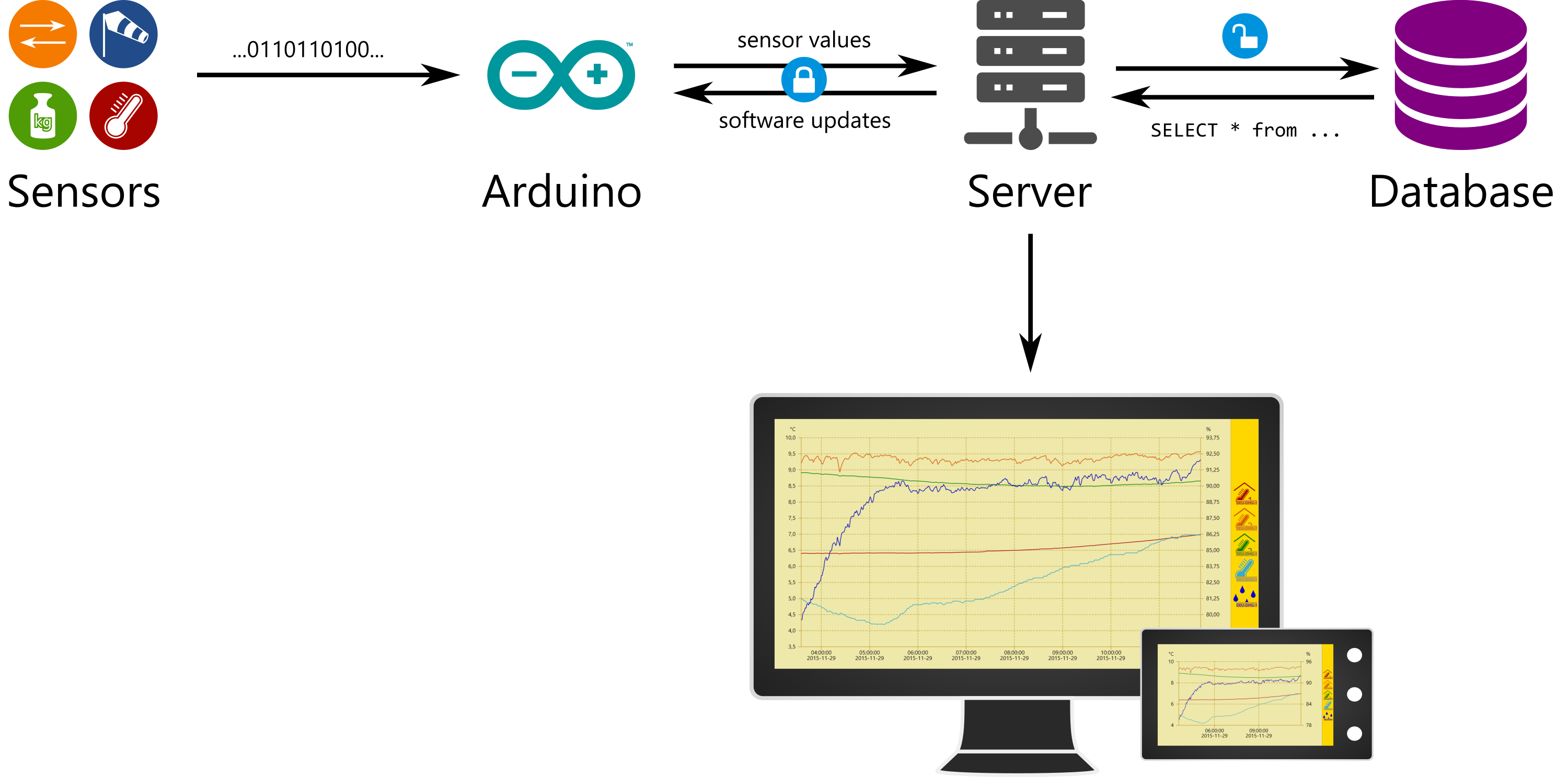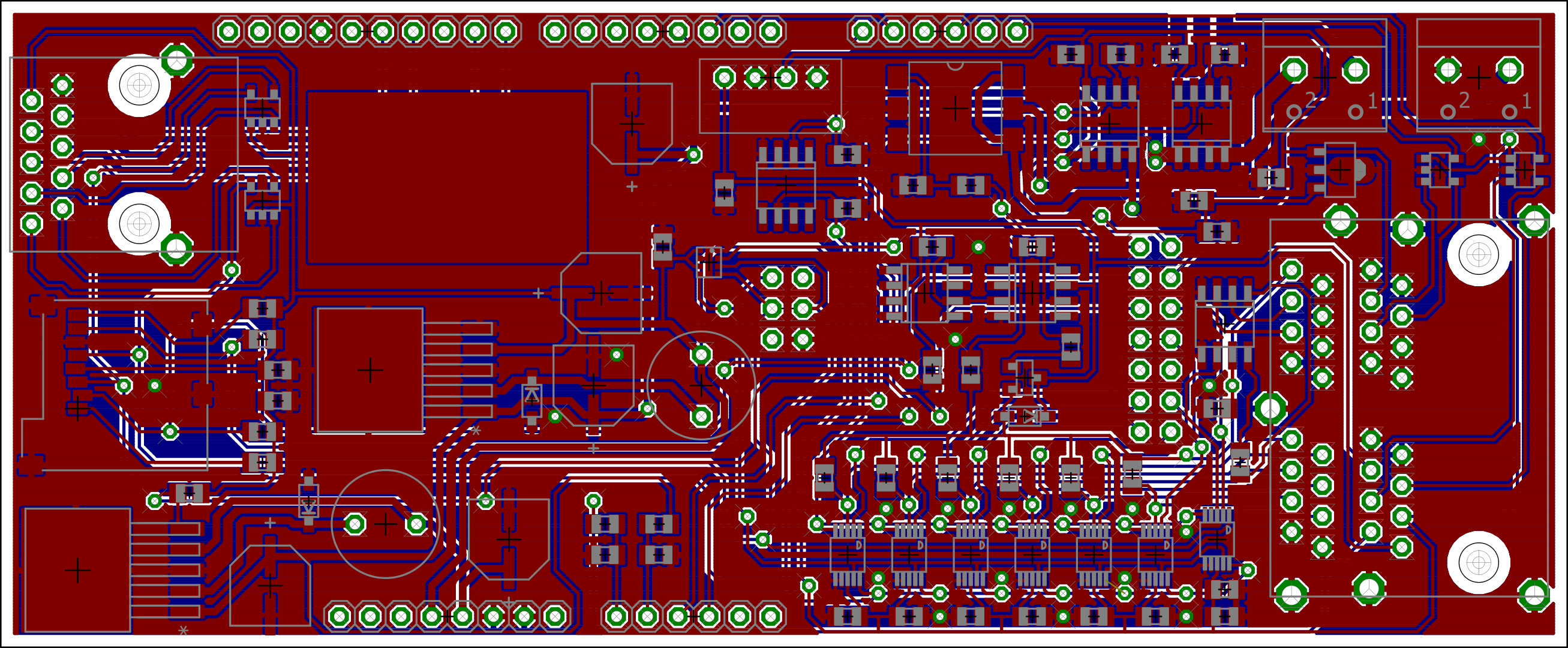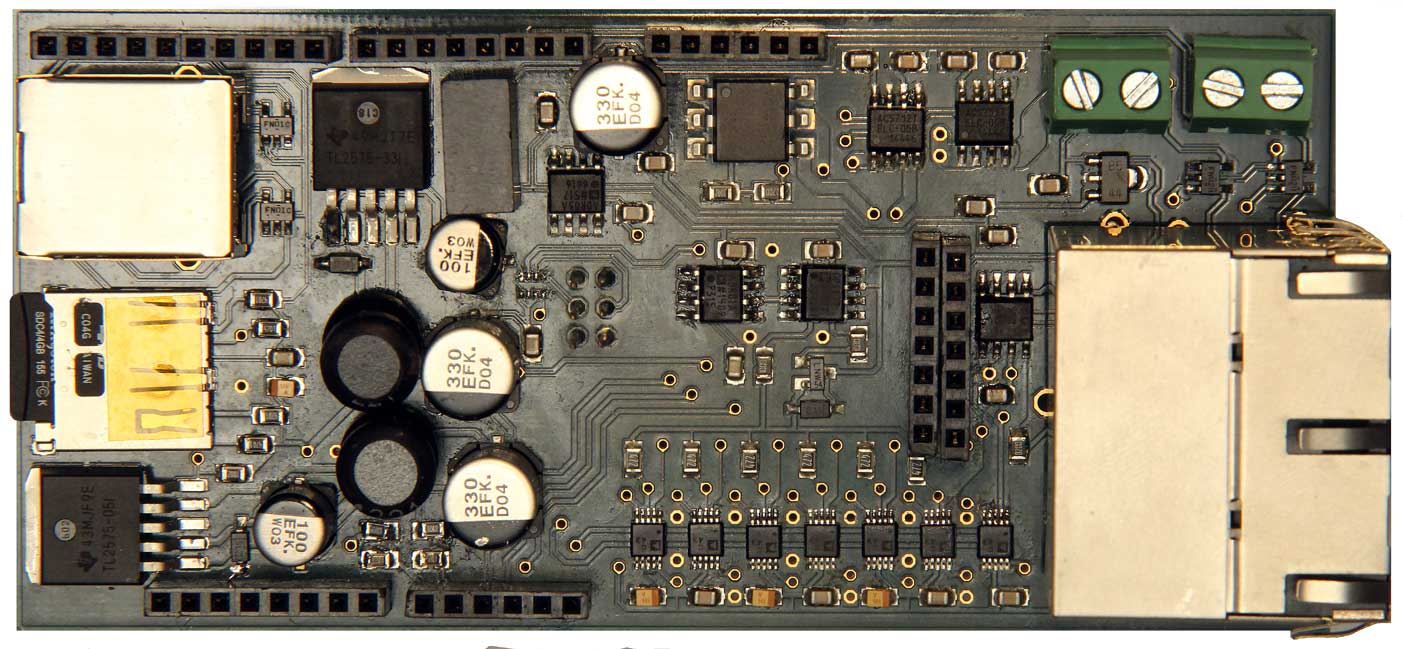The software system
Basically, BeeBIT establishes a network of several clients, one per bee box, which collect sensor data and send it to a central server. The central server stores the data in a database which is connected to the internet to enable a wide range of applications.

As for the clients, we use an Arduino Due to collect the data. In the aftermath, we partially regret our decision to have chosen such a device; on the one hand, it simplifies access to some obvious Features, but sometimes Blocks or at least hinders the use of some more complex and subtle functions of the microprocessor. For example, as we wanted to query the temperature sensor of the microcontroller, we had to access the specific component directly, because the Arduino abstraction did not implement such a feature. And of course, our implementation is not compatible with Arduino’s one. So, for small projects, the Arduino might have been the perfect choice, but in our case, it made things harder.
In the recent time, we have implemented some revolutionary Features on the Arduino you might also be interested in (I’ll describe them here in a hopefully high level form. If you are interested in a more technical explanation, you can contact us directly.
Encryption using the mbedTLS library
Well, this is one of the more obvious ones. It is easy to implement a library, right? But we developed our own way of encryption: Each, server and the clients, got their own keys and they basically generate temporary keys to communicate with each other. We can easily authenticate and authorize our clients at the server, and the encryption has shown to only lead to small performance issues about every 30 minutes when client and server exchange new keys to communicate with each other.
GSM on the Arduino Due (i.e. cellular communication)
As you might know, the Arduino GSM library does only work for AVR-based chips which the Arduino Due is not. So we had to develop an own version of it (it only Features internet, no SMS or call functionality is planned to be implemented, as we don’t really need it; we wanted to develop a library from scratch, because the Arduino GSM library felt a bit too bulky, we thought), we are currently tweaking it a bit.
Firmware-Over-The-Air functionality
This was maybe the biggest challenge in developing the software: How to update the software of the Arduino without plugging it to a computer, so we can automatically distribute updates? Well, we did it! We just write the data from some position in our flash storage to the position where the program is executed, and we do this all from RAM. Then we just reset the microcontroller. It sounds really easy when described in such a high level way, but there is hardly any resources on this topic (specifically when you try to update an Arduino…) except from the datasheet and some additional notes by the manufacturer.
The best part about it: The update is independent from the type of internet connection (GSM or Ethernet) and is also encrypted to secure the network even further. The code used for the update might also work on other Atmel-ARM-SoCs, at least on those that include the RSTC and EFC controllers.
Data visualisation: Diagram
But we not only made some progress with client software (by the way, we are currently recording data experimentally, using the GSM library and the encryption and successfully sent some updates). We also tweaked the server software and the database and added a live diagram which is still in an early stage of development. With it, you will are able to display the data in a way which not only computer scientists can understand. It is developed as a responsive website, so it is fully functional on most devices, from smartphone to desktop. You can view up to eight different sensors at once and scroll through all our test data. As mentioned previously, we already translated it into six languages, more to follow. Pretty cool, isn’t it? You will even be able to see when new data comes in approximately every ten minutes! By the way, you can find it here: Diagram. Have fun! If you have any suggestions for improvements or found a bug, please contact us.
The hardware system


After we revised the circuit diagram and the layout of the PCB, two prototypes were produced in September. The boards were ordered by an external company and manually assembled by us with nearly 90 parts and over 400 soldering joints. The SMD parts were reflow soldered. First, the solder paste was dabbed on the pads of the board and then it was populated. After all, the whole PCB with the components sticking on it was heated till the solder paste melted. The through-hole components were soldered with a soldering iron, what needs to be done in this way later as well, because in the regular soldering process, the wave soldering, too much solder would be deposited at the pins, which must fit into the Arduino. The SMD parts will be assembled later by a pick-and-place machine.
One of the two prototypes is in use at the Umweltstation Würzburg right now.
(jg) 2015-11-29
Newsflash
Formation of BeeBIT e.V.
BeeBIT was registered as a non-profit association and is now called "BeeBIT e.V." (the addendum "e.V." is the German abbreviation for registered association). By establishing the association we hope to simplify and merge the structure of our project, so that working with us together trustfully on a regional as well as on an international level becomes more easier and concrete – both for our partner schools as well as for external institutions, companies and educational facilities. The association's scope of duties herein will be of an organizational character, particularly with regard to communication, project organization and public relations.
Meeting with Project Partners
From the 1st November to the 4th November, the project partners from all over Europe came to Würzburg for a meeting with the BeeBIT team. We mainly discussed the status and further planning of the entire BeeBIT project. They also recieved an introduction to the BeeBIT homepage and translated the diagram in their mother tongues, so we got six available languages by now (German, English, Italian, Swedish, Slovenian and Croatian, more to follow).
Awards
In the course of the so called "Land der Ideen" contest, our project was decorated with a prize. The contest was founded by the past German government and is yearly assigned to innovative and creative ideas from around the country. On October 21st the award was submitted at Friedrich-Koenig-Gymnasium in the context of a colloquium of natural sciences. On November 11th Christoph Bauer (FKG) and Arnold Weibel (DHG) represented BeeBIT e.V. at the awardee meeting in Berlin.
BeeBIT in German TV
On the 2nd November, the German TV broadcaster of the federal country Bavaria, the Bayerische Rundfunk, came to us to shoot a short report about our project. They interviewed our software engineer, David Schneller, a member of our association board, Christoph Bauer, and a student of the FKG grammar school. Unfortunately, the report is currently no longer available.
MINT-EC congress
On the 13th and 14th of November the German headmaster congress for participating MINT-EC (Excellence schools in STEM subjects) schools took place at the Friedrich-Koenig-Gymnasium. Martin Otersen (DHG) and Christoph Bauer (FKG) held a workshop about the BeeBIT project and informed about the eHive, especially about how to get involved in the project. Both options, purchasing an eHive or alternatively securing access to the collected data and provided materials by acquiring membership in our network were mentioned and explained.
Cooperation
Thanks to Schneider Electric, a global player in matters of electronic components with around 170.000 employees worldwide, BeeBIT e.V. can benefit of the support from a gifted and well-versed partner. Schneider Electric is involved in producing the eHive's new, improved and finally working circuit board. This board is planned to be finished at the beginning of January, which means we are able to ship the missing modules until the end of January to our European partners. In February all delivered eHives should be able to connect to the network and provide real-time data. At the moment this is our very first priority.
Besides that, Schneider Electric also offered us support on developing and producing better technical solutions for the eHive. Consequently, in the background we are beginning to work on enlarging the network and think about how to benefit from the offered possibilities.
Furthermore, we initiated a partnership with the LMU Munich, who will take over the duties of the University of Würzburg. This includes the creation of teaching materials and the scientific monitoring of didactics-related tasks. There will also be possibilities for final theses using our data. We would like to thank Dr. Monika Aufleger from the Institute of Biology Education.
We also want to thank the Umweltstation Würzburg, the conversation agency of Würzburg. Since the very beginning of our project, they supported us with knowhow and tools regarding beekeeping. Besides, two of our eHives are located on their site.
School seminar
The BeeBIT project emerged from a so called “Projekt-Seminar” at the Deutschhaus-Gymnasium more than two years ago. This autumn another seminar started which is thematically related. Its purpose is to support and enlarge our team. Until next spring their most talented programmers are working on a multilingual administration system for education materials. Additionally, the group produces a corporate video about the project featuring a 3d-model of the eHive and its important parts.
(cw, ds, cb, jh) 2015-11-28
The eHive project
With this article, we want to give you an overview of the project, its possibilities in education and research and the current progress of development.
What are we trying to achieve?
In the past decade a huge amount of bee colonies collapsed, currently about 40% per year. Scientists have good reasons to fear this development as the honey bee is one of the most important useful animals of our agricultural system. But currently we understand only a small fraction of the bee’s biology and behavior which results in a lack of projects to fight death of bee colonies. With our BeeBIT eHives, we want to establish a tool for professional bee research as well as motivate pupils to engage in bee research.
What exactly is an eHive?
The root of the BeeBIT Project is the HOBOS Project of the University of Würzburg. The HOBOS System is a special bee hive, monitored by high-tech sensors whose data is published on the Internet. But it is only a single Hive, placed in a narrowly defined geographic and environmental setting. Its data is barely transferable to other colonies in other regions of the world. This is the basic idea of the eHive: A relatively inexpensive system for monitoring bee colonies which can easily be bought and set up by schools and other educational institutions.

Every eHive contains a set of probes: 6 Temperature sensors and a humidity sensor monitor the micro climate of the bee hive. A scale underneath the hive makes it possible to draw conclusions on the colony’s honey yield. A proprietary sensor for measuring bee approaches and departures shows the activity of the hive. An industry-standard weather station delivers highly accurate environment data – all those parameters are recorded every minute and can be sent to the server in real-time.
As an Institution of Education, how to benefit from the project?
The BeeBIT project is funded by the Erasmus-Plus-Program of the European Union to create teaching materials based on the eHive’s data. This enables the pupils to work with real, close to reality examples, no matter if in Biology, Math or Computer Science lesson. A sample lesson is available on our homepage. The lessons created during the Erasmus-Plus-Project will be available for free on our homepage. If you created lessons based on our data and want to share it with other schools, feel free to contact us!
Of course, custom projects led by pupils are also possible, which can promote bicultural understanding as pupils can work together across borders.
As an Institution of Research, how to benefit?
As all the eHives are constructed in the same way, the project enables scientists not only to monitor a single colony, but plenty of colonies in totally different regions. Consequently, we collect comparable data that may help to understand the life and death of bees. For example, a colony collapse disorder event was never recorded by sensors – by monitoring several colonies, we may be able to produce such valuable data.
(team) 2015-08-01